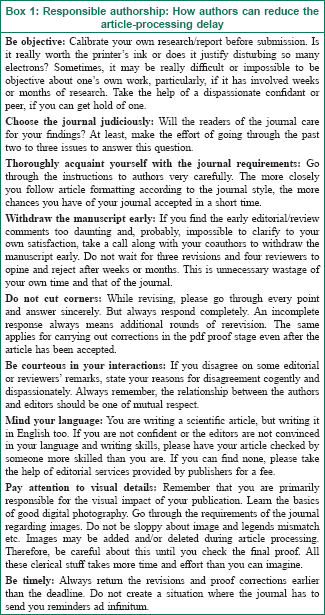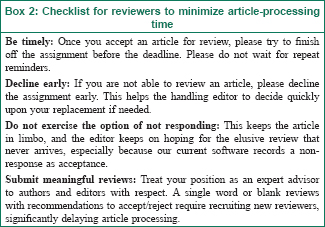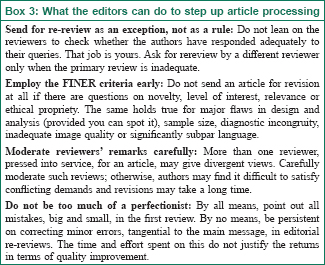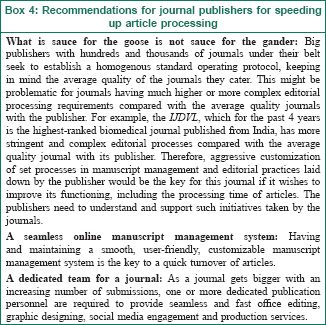Translate this page into:
Article processing speed in the Indian Journal of Dermatology, Venereology and Leprology
Correspondence Address:
Saumya Panda
Editor-in-Chief, IJDVL, Ashok-Swapna, 122/4, Dr Jiban Ratan Dhar Road, Kolkata 700028, West Bengal
| How to cite this article: Panda S. Article processing speed in the Indian Journal of Dermatology, Venereology and Leprology. Indian J Dermatol Venereol Leprol 2020;86:471-474 |
It is now time for some introspection—by everyone. We are publishing two brief reports in this issue that attempt to dissect the problem of long processing time of articles in our journal. The views are from two opposing sides of the mirror—one report having been written by regular, long-suffering authors from the dermatology department of a reputed institution from where articles feature in almost every issue of this journal and the other written by long-time editors, including the emeritus editor, of this journal, who have analyzed the problem as insiders, having the benefit of access to data which are not available to the outside world. As the perspectives and data available to the two sets of authors are entirely different, so are, expectedly, the conclusions. However, despite the divergences in the quality of data, analysis and reporting, we must acknowledge that the efforts put in by two unrelated sets of authors to scientifically answer closely related research questions referring to the turnover time of articles in the Indian Journal of Dermatology, Venereology and Leprology(IJDVL) is a stark testimony to the perception that we have an issue, indeed, with manuscript processing time in the journal and the time is ripe to confront it headlong.
What are the parameters or variables upon which the publication time in a journal—any journal—depends? Publication is a multifaceted process requiring meticulous efforts and planning put in by authors, reviewers and the editorial team.[1] The causes of delay in the process can be attributed to several reasons related broadly to one or more of these stakeholders.
Dissecting the Parameters of Delay
General factors
A survey with researchers (n = 1038) carried out in 2012 showed that publication speed was the third most important factor in their choice of journal, after the paper's fit with the subject area of the journal and the importance of the journal as measured by the impact factor.[2]
Kalcioglu et al. examined a 15-year period of 37 journals and detected large variations in the time needed until acceptance. This period varied between 1 and 1195 days for original research papers and between 1 and 1145 days for case reports, which means that peer review has the potential to be drawn out for as long as 170 weeks, that is, more than 3 years.[3] Among major dermatology journals, the Journal of the American Medical Association Dermatology declared a median receipt to publication time of 133 days in 2017.[4] In this perspective, the average time of acceptance (for original articles, case reports and letters to the editor) in the IJDVL (5.85 months or around 175 days) may be termed as unexceptional, but something that can be bettered.[5]
As was determined in a slightly dated survey, 38% of authors noted that peer review, as a process, was too slow—19% of the authors were satisfied but 60% were dissatisfied if the length of peer review varied between 3 and 6 months; the percentage of satisfaction decreased to 9%, but the percentage of dissatisfaction increased to 80% when peer review exceeded 6 months.[6]
There is evidence that reviewing time is increasing across the journals.[7],[8] The authors think that this is because reviewers are requesting more data, revisions and new experiments or methods than they used to. The journal editors' viewpoint is that science itself has become more data-rich and the journals work to uphold high editorial and peer review standards.[8] Both may be right. In addition, journals are also receiving more submissions. Just to exemplify, in this pandemic year, until this day, the IJDVL has seen a total submission of 1088 articles compared with a total of 1105 submissions in the whole of 2019.
What can we do to reduce these delays?
The role of authors
The authors should submit meaningful papers to the appropriate journal. “Stop playing the submission system like a lottery; this clogs the pipeline with papers that are not matched to the journal,” as Vosshall said.[9] A direct effect of hurried, premature, poorly conducted and improperly reported studies and scientific reports is a large proportion of editorial rejections. The reasons and extent of this in the IJDVL have been brought out impressively by Gupta et al. in [Table 2] of their report.[10] If we take a look at the 10 major reasons of editorial rejection identified by them, we would see that all these are preventable in the sense that the authors could obviate the rejection, either by not submitting the articles either in this journal (”similar article published recently in the journal”) or elsewhere (”lack of novelty,” “flawed methodology,” “incorrect diagnosis,” etc.) or by taking adequate care while submitting the manuscripts (”poor quality images,” “instructions to authors not followed,” “text difficult to follow,” etc). This is a major issue behind publication delay if we take into account the fact that as many as 55% of the submitted manuscripts in the IJDVL faced editorial rejection because of the reasons stated above, even before external peer review.[10] Being a dermatology journal, IJDVL puts a high premium on image quality, and poor quality images can doom an otherwise reasonable report.
Authors should read journal instructions carefully and prepare their manuscripts accordingly. This is particularly important when a manuscript rejected by one journal is submitted to another. In another revealing statistic, it was found that the reason for which an article is sent back to authors for preliminary revision is “not following author instructions” in as many as 97.8% of cases![10] There is a strong case for standardizing author instructions across journals to save on this avoidable work; however, currently, authors will find themselves well-rewarded for making the effort.
The authors should respond promptly and completely to editorial and referee questions and suggestions. If some data or clarification requested cannot be supplied, it should be explicitly stated rather than evading the question or providing irrelevant answers. If they disagree with a comment, it should be stated with civility and be backed with evidence. Proofs should be read carefully and promptly returned.
The ways and means by which authors can demonstrate responsible authorship and may play a positive part in reducing article processing time have been summarized in [Box 1].

The reviewer conundrum
Peer review is the cornerstone of current editorial processes. Like all other leading journals, we greatly value the contributions of our referees. It has now become fashionable to disparage the peer review system for all that is going wrong regarding academic publication, including what some critics term as its “glacial pace.”[9] However, peer review is irreplaceable in foreseeable future, and we have to live with that fact.[11]
However, in my experience, reviewers—good reviewers—sometimes forget that their role is to advise authors and editors to help them avoid publishing something incomplete, wrong or flawed. Ultimately, the authors are responsible for the content in the paper, and they bear the responsibility of being right.[9] It is best to avoid fixating on minor details as this can lead to unnecessary delays.
We would also request referees to respond promptly when invited to review an article. They should decline immediately if they are unable to undertake the task, and if they accept, they must provide a considered assessment of the manuscript.
We may think aloud here: Is open peer review the way forward, in which reviewers' names and comments are posted alongside articles? Will it be the harbinger of transparency and accountability?[11] Will it prevent unnecessary delays too?
The dwindling pool of efficient reviewers, who deliver a good job in time, may have to do with one key factor, which is the pro bono nature of peer reviewers. Editors and the editor-in-chief may feel that they are unable to pressurize peers to complete a task in time because such peers are already being exploited for free.[12]
[Box 2] provides a guide for reviewers willing to do their bit for reducing article-processing delay.

What is to be done by the editors
As described previously, the editorial process in the IJDVL consists of triage and primary screening, external peer review and secondary screening, postpeer review editing and final editing by the senior editorial team.[13] Given this process, which is perhaps a bit more elaborate than most comparable journals, editors take up a larger share of time in the processing of articles inthis journal. However, given our twin concerns of inadequate quality of our average submission and our striving for excellence of our published matter, these many layers of editorial supervision cannot be dispensed with in the near future.
However, the single most important act an editor can perform to speed peer review is to avoid multiple rounds of review [Box 3].[9] Re-reviews must be an exception rather than the rule. This should be resorted to only in case of manuscripts where the handling editor lacks adequate expertise himself or herself and does not get necessary guidance from the peers during the first round of review.

One way to reduce processing time and conserve editorial resources is to be more ruthless in rejecting articles that may require multiple rounds of review and revisions. Manjunath et al. suggest that there should be a ceiling on the number of revisions that a manuscript undergoes.[5] However, at the IJDVL, we have consciously chosen to work with authors to improve manuscripts in which we see some scientific value even if the initial submission is of suboptimal quality. The process takes long and absorbs editorial resources, sometimes over several months. Often and satisfyingly, this effort leads to publication. At other times, several exchanges over many weeks lead us to finally conclude that the manuscript does not make the cut. Authors are usually disappointed (and occasionally upset) with such an outcome after a long drawn out editorial process; we are disappointed too but recognize that this is the price we have chosen to pay with our editorial policy of choosing engagement over summary rejection.
Where does the publisher stand?
The role of the publisher in facilitating manuscript processing is crucial. A good manuscript management system makes for pleasant and quick work for authors, reviewers and editors alike. It is good news that, finally, the IJDVL is set to migrate to a new system that, we hope, will encourage all stakeholders.
After acceptance, but before publication, there are still several steps during production, including copyediting, proofreading and indexing, for which the publisher is responsible. Good copy editing and proofreading, carrying out editorial instructions consistently and cutting out redundant and repetitive steps will help speed the process. In the IJDVL , we have taken on some of this responsibility that is traditionally of the publisher. We have a separate team to correct language and make articles more readable and a set of editors to ensure that images appear optimally. In addition, we have employed a tech-savvy editorial assistant to help us deal with the current software system, perform a technical check of newly submitted articles and sundry other responsibilities of the editorial office.
Finally, an aspirational proposal for the establishment of scientific publishing: We are living in a global economic system driven by the rules of a marketplace. Still, biomedical (and scientific) publishing is ruled by an anachronistic practice, whereby, it is dependent upon pro bono services rendered by editors and reviewers. The tasks behind the publication of a solidly vetted scientific paper are complex and numerous. The actualization of this requires good management, respect, trust, courage and, most importantly, a lot of hard work and dedication by the editorial team members. Despite this tremendous responsibility bestowed upon editors, they are not financially compensated for their efforts.[14] This is, plainly speaking, exploitative. The result is jaded editors cutting corners, or procrastinating, because of lack of tangible incentives or a fading altruistic desire to serve the academic community. Such demotivation may go some way in explaining long editorial decisions. Perhaps, it is time that everyone thinks seriously in terms of compensating the peers and the editors for their time, labor and expertise.
[Box 4] summarizes some recommendations for the publishers for accelerating the process of publication.

What are we doing to address delays?
Examples of new initiatives taken by the editors to hasten the publication process in this journal are a proposal by the editors to have an option in the newly developing manuscript management system for automatic seeding of the reviewer database by our authors, reduction in the number of redundant phases in the production and editorial processes, stopping the practice of multiple proofs being sent to the authors and limiting it one pdf proof for the authors of each article, and so on.
Conclusion
Knowledge diffusion is an intrinsically slow process.[15] Publication experiences during this pandemic have taught us that we can forget this truth and try to accelerate the pace of scientific publication at the expense of marginalizing, downgrading and, sometimes, doing away with peer and editorial review processes only at our own peril.[16] The turnover time of articles in a journal is a function of multiple variables, namely, the efficiency of authors, the average quality of the submission, strength of the reviewer pool, the responsiveness of the editorial team, the complexity of the editorial process and the culture of timeliness prevailing in the journal. Thus, the responsibility of reducing the turnover time rests upon all the stakeholders, namely, the authors, reviewers, editors and publishers. The two brief reports[5],[10] and this accompanying commentary should be a testimony to the fact that the journal takes the twin tasks of introspection and self-criticism seriously. We wish to assure our readers that the editorial team is always looking for ways to innovate to reduce manuscript processing delays and ensure timely publication of evidence and data, without compromising on our editorial and review processes, to maintain and enhance the integrity of published data in the IJDVL.
Acknowledgment
The author acknowledges the contributions of Prof. M Ramam, Professor, Department of Dermatology, All India Institute of Medical Sciences, New Delhi and Prof Debabrata Bandyopadhyay, Professor and Head, Department of Dermatology, Calcutta Medical College, Kolkata, for suggesting extensive revisions and re-revisions that have improved the text considerably.
| 1. |
Shah A, Sherighar SG, Bhat A. Publication speed and advanced online publication: Are biomedical Indian journals slow? Perspect Clin Res 2016;7:40-4.
[Google Scholar]
|
| 2. |
Solomon DJ, Björk BC. Publication fees in open access publishing: Sources of funding and factors influencing choice of journal. J Assoc Informat Sci Technol 2012;63:98-107.
[Google Scholar]
|
| 3. |
Kalcioglu MT, Ileri Y, Karaca S, Egilmez OK, Kokten N. Research on the submission, acceptance and publication times of articles submitted to international otorhinolaryngology journals. Acta Inf Med 2015;23:379-84.
[Google Scholar]
|
| 4. |
Robinson JK. JAMA Dermatology – The year in review, 2017. JAMA Dermatol 2018;154:399-401.
[Google Scholar]
|
| 5. |
Manjunath S, Bhattacharjee R, Razmi TM, Narang T, Vinay K. A comparative study on the turnaround time of article processing in dermatology journals: A need for improvement of this aspect in Indian journals. Indian J DermatolVenereol Leprol 2020;86:526-30.
[Google Scholar]
|
| 6. |
Mark Ware Consulting Ltd. Peer review in scholarly journals: perspective of the scholarly community – An international study. Commissioned and Funded by the Publishing Research Consortium; 2008. p. 16. Available from: http://www.publishingresearch.net/documents/PeerReviewFullPRCReport-final.pdf. [Last accessed on 2020 Jul 21].
[Google Scholar]
|
| 7. |
Himmelstein DS, Powell K. Analysis for “the history of publishing delays” blog post v1. 0. Zenodo Repository 2016. Available from: http://doi.org/bb95. [Last accessed on 2020 Jul 21].
[Google Scholar]
|
| 8. |
Powell K. The waiting game. Nature 2016;530:148-51.
[Google Scholar]
|
| 9. |
Vosshall LB. The glacial pace of scientific publishing: Why it hurts everyone and what we can do to fix It. FASEB J 2012;26:3589-93.
[Google Scholar]
|
| 10. |
Gupta V, Bhatia R, Pathak M, Ramam M. Analysis of submissions, editorial and peer-review process, and outcome of manuscripts submitted to the Indian Journal of Dermatology Venereology and Leprology over a 6-month period. Indian J Dermatol Venereol Leprol 2020; 86: 519-25.
[Google Scholar]
|
| 11. |
Panda S. The peer review process: Yesterday, today and tomorrow. Indian J Dermatol Venereol Leprol2019;85:239-45.
[Google Scholar]
|
| 12. |
Teixira da Silva JA, Dobranszki J. Excessively long editorial decisions and excessively long publication times by journals: Causes, risks, consequences, and proposed solutions. Pub Res Q2017; 33: 101-8.
[Google Scholar]
|
| 13. |
Ramam M. The manuscript review process: What do editors do? Indian J Dermatol Venereol Leprol 2016;82:599-602.
[Google Scholar]
|
| 14. |
Teixeira da Silva JA, Katavic´ V. Free editors and peers: Squeezing the lemon dry. Ethics Bioeth 2016;6:203-9.
[Google Scholar]
|
| 15. |
Sebo P, Fournier JP, Ragot C, Gorioux JP, Hermann FR, Maisonneuve H. Factors associated with publication speed in general medical journals: a retrospective study of bibliometric data. Scientometrics 2019;119:1037-58.
[Google Scholar]
|
| 16. |
Panda S. Publishing in the time of pandemic: Editorial policy of a dermatology journal during COVID-19. Indian J Dermatol Venereol Leprol 2020;86:337-40.
[Google Scholar]
|
Fulltext Views
48,786
PDF downloads
7,763





